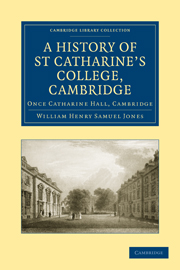Chapter I - Site and Buildings
Published online by Cambridge University Press: 05 June 2011
Summary
St catharine's college was founded in 1473 by Robert Woodlark, Provost of King's, whose life and work are given in Chapter II.
The site chosen by Woodlark for the new foundation was quite close to King's College. If one were to take Queens' Lane, the north wall of the Hall, and lines drawn at right angles to these from the centre of the lawn, the rectangle thus formed would probably include all the original buildings. Browne says that during the drought of 1877 “we saw very clearly on the grass of the College Court the lie of the Chapel walls and the corner buttresses; they extended about halfway across the grass-plot from west to east, and about halfway also from north to south”.
Some preparatory steps were taken at least as early as 1459, for on 10 September in that year Woodlark bought two tenements in Milne Street, situated in the parishes of St Edward and St Botolph, between the tenement of John Rasour to the south and a tenement belonging to Michael House on the north. They abutted on a tenement of Corpus Christi (le George) to the east, and on Milne Street to the west. The northern boundary was 90 feet, the southern 107 feet 2 inches. The tenements were subject to a quit rent of 3 shillings a year payable to the Master and Scholars of Michael House.
Milne Street (“the street of the mills”) was the old name of Queens' Lane, once one of the main thoroughfares of the town. The boundary between the two parishes passes through the entrance to the present D staircase.
- Type
- Chapter
- Information
- A History of St Catharine’s College, CambridgeOnce Catharine Hall, Cambridge, pp. 3 - 43Publisher: Cambridge University PressPrint publication year: 2010First published in: 1936



